Strategic Management for Five Guys in Belgium Market
VerifiedAdded on 2023/04/20
|16
|4229
|490
AI Summary
This report presents the strategic issue of how to effectively enter the Belgium market for Five Guys. It includes an analysis of Belgian culture, the fast food market in Belgium, and competitive strategies. Recommendations are provided for methods of expansion, location recommendations, product mix, marketing, and implementation of strategic direction.
Contribute Materials
Your contribution can guide someone’s learning journey. Share your
documents today.
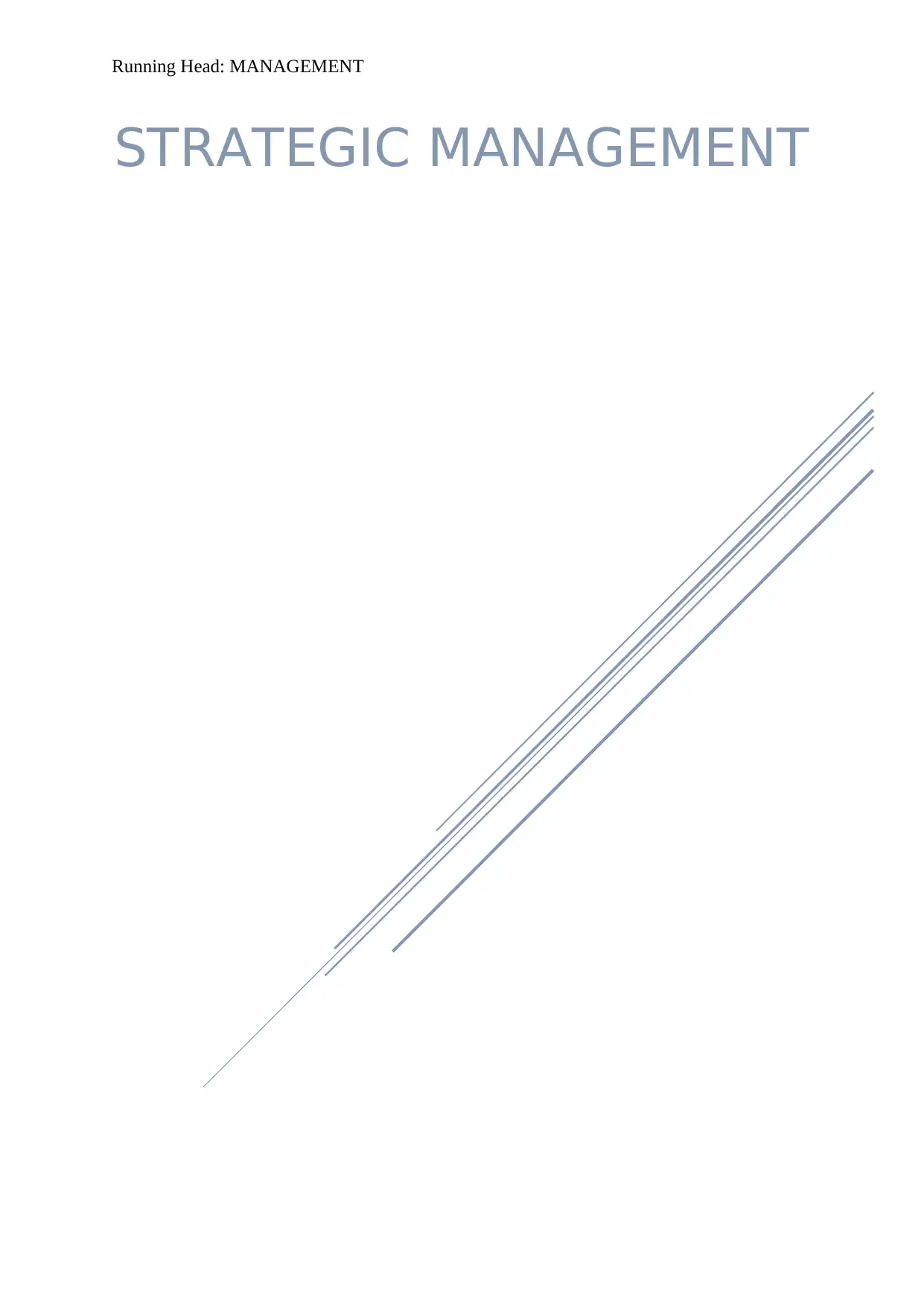
Running Head: MANAGEMENT
STRATEGIC MANAGEMENT
STRATEGIC MANAGEMENT
Secure Best Marks with AI Grader
Need help grading? Try our AI Grader for instant feedback on your assignments.
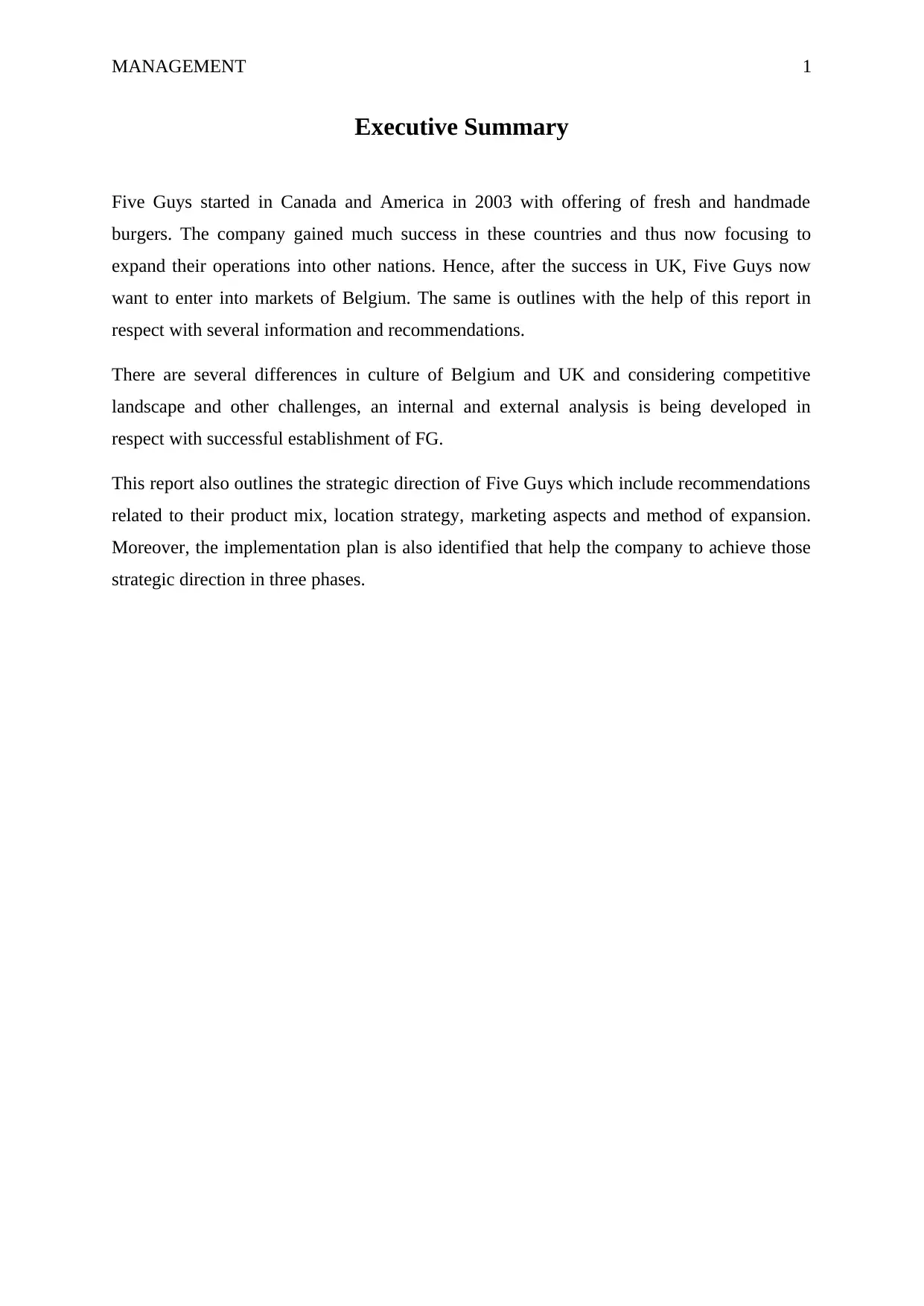
MANAGEMENT 1
Executive Summary
Five Guys started in Canada and America in 2003 with offering of fresh and handmade
burgers. The company gained much success in these countries and thus now focusing to
expand their operations into other nations. Hence, after the success in UK, Five Guys now
want to enter into markets of Belgium. The same is outlines with the help of this report in
respect with several information and recommendations.
There are several differences in culture of Belgium and UK and considering competitive
landscape and other challenges, an internal and external analysis is being developed in
respect with successful establishment of FG.
This report also outlines the strategic direction of Five Guys which include recommendations
related to their product mix, location strategy, marketing aspects and method of expansion.
Moreover, the implementation plan is also identified that help the company to achieve those
strategic direction in three phases.
Executive Summary
Five Guys started in Canada and America in 2003 with offering of fresh and handmade
burgers. The company gained much success in these countries and thus now focusing to
expand their operations into other nations. Hence, after the success in UK, Five Guys now
want to enter into markets of Belgium. The same is outlines with the help of this report in
respect with several information and recommendations.
There are several differences in culture of Belgium and UK and considering competitive
landscape and other challenges, an internal and external analysis is being developed in
respect with successful establishment of FG.
This report also outlines the strategic direction of Five Guys which include recommendations
related to their product mix, location strategy, marketing aspects and method of expansion.
Moreover, the implementation plan is also identified that help the company to achieve those
strategic direction in three phases.
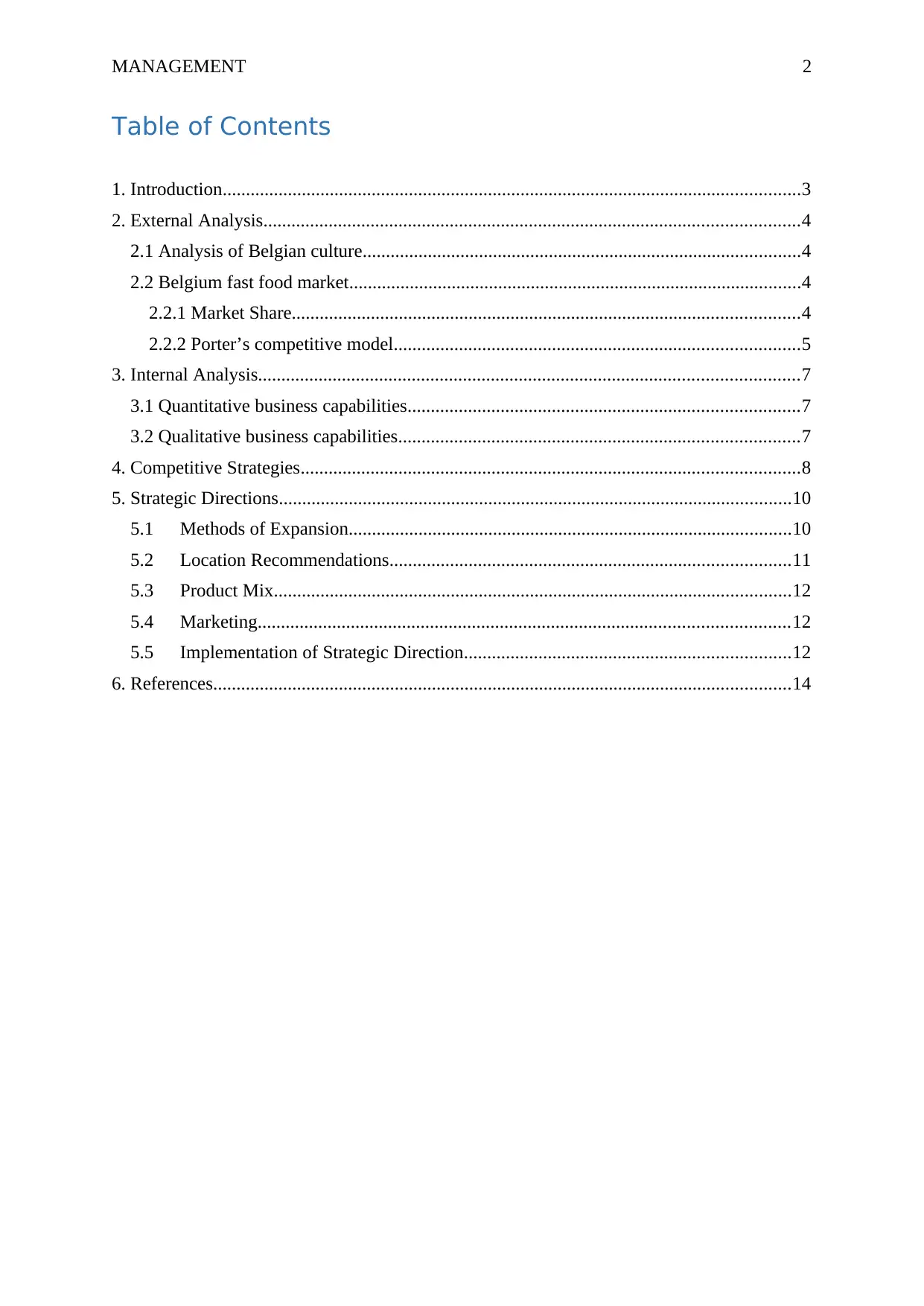
MANAGEMENT 2
Table of Contents
1. Introduction............................................................................................................................3
2. External Analysis...................................................................................................................4
2.1 Analysis of Belgian culture..............................................................................................4
2.2 Belgium fast food market.................................................................................................4
2.2.1 Market Share.............................................................................................................4
2.2.2 Porter’s competitive model.......................................................................................5
3. Internal Analysis....................................................................................................................7
3.1 Quantitative business capabilities....................................................................................7
3.2 Qualitative business capabilities......................................................................................7
4. Competitive Strategies...........................................................................................................8
5. Strategic Directions..............................................................................................................10
5.1 Methods of Expansion...............................................................................................10
5.2 Location Recommendations......................................................................................11
5.3 Product Mix...............................................................................................................12
5.4 Marketing..................................................................................................................12
5.5 Implementation of Strategic Direction......................................................................12
6. References............................................................................................................................14
Table of Contents
1. Introduction............................................................................................................................3
2. External Analysis...................................................................................................................4
2.1 Analysis of Belgian culture..............................................................................................4
2.2 Belgium fast food market.................................................................................................4
2.2.1 Market Share.............................................................................................................4
2.2.2 Porter’s competitive model.......................................................................................5
3. Internal Analysis....................................................................................................................7
3.1 Quantitative business capabilities....................................................................................7
3.2 Qualitative business capabilities......................................................................................7
4. Competitive Strategies...........................................................................................................8
5. Strategic Directions..............................................................................................................10
5.1 Methods of Expansion...............................................................................................10
5.2 Location Recommendations......................................................................................11
5.3 Product Mix...............................................................................................................12
5.4 Marketing..................................................................................................................12
5.5 Implementation of Strategic Direction......................................................................12
6. References............................................................................................................................14
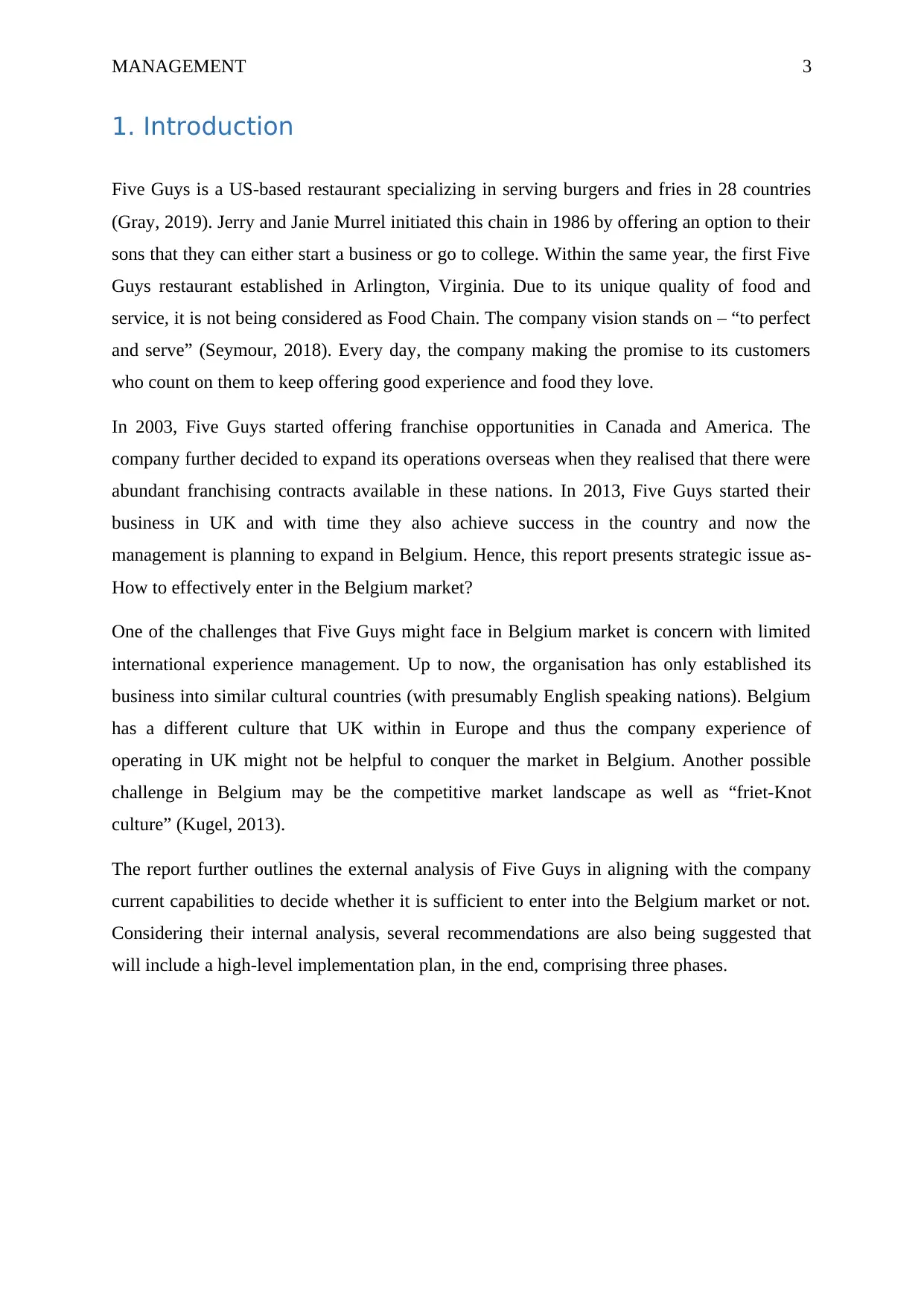
MANAGEMENT 3
1. Introduction
Five Guys is a US-based restaurant specializing in serving burgers and fries in 28 countries
(Gray, 2019). Jerry and Janie Murrel initiated this chain in 1986 by offering an option to their
sons that they can either start a business or go to college. Within the same year, the first Five
Guys restaurant established in Arlington, Virginia. Due to its unique quality of food and
service, it is not being considered as Food Chain. The company vision stands on – “to perfect
and serve” (Seymour, 2018). Every day, the company making the promise to its customers
who count on them to keep offering good experience and food they love.
In 2003, Five Guys started offering franchise opportunities in Canada and America. The
company further decided to expand its operations overseas when they realised that there were
abundant franchising contracts available in these nations. In 2013, Five Guys started their
business in UK and with time they also achieve success in the country and now the
management is planning to expand in Belgium. Hence, this report presents strategic issue as-
How to effectively enter in the Belgium market?
One of the challenges that Five Guys might face in Belgium market is concern with limited
international experience management. Up to now, the organisation has only established its
business into similar cultural countries (with presumably English speaking nations). Belgium
has a different culture that UK within in Europe and thus the company experience of
operating in UK might not be helpful to conquer the market in Belgium. Another possible
challenge in Belgium may be the competitive market landscape as well as “friet-Knot
culture” (Kugel, 2013).
The report further outlines the external analysis of Five Guys in aligning with the company
current capabilities to decide whether it is sufficient to enter into the Belgium market or not.
Considering their internal analysis, several recommendations are also being suggested that
will include a high-level implementation plan, in the end, comprising three phases.
1. Introduction
Five Guys is a US-based restaurant specializing in serving burgers and fries in 28 countries
(Gray, 2019). Jerry and Janie Murrel initiated this chain in 1986 by offering an option to their
sons that they can either start a business or go to college. Within the same year, the first Five
Guys restaurant established in Arlington, Virginia. Due to its unique quality of food and
service, it is not being considered as Food Chain. The company vision stands on – “to perfect
and serve” (Seymour, 2018). Every day, the company making the promise to its customers
who count on them to keep offering good experience and food they love.
In 2003, Five Guys started offering franchise opportunities in Canada and America. The
company further decided to expand its operations overseas when they realised that there were
abundant franchising contracts available in these nations. In 2013, Five Guys started their
business in UK and with time they also achieve success in the country and now the
management is planning to expand in Belgium. Hence, this report presents strategic issue as-
How to effectively enter in the Belgium market?
One of the challenges that Five Guys might face in Belgium market is concern with limited
international experience management. Up to now, the organisation has only established its
business into similar cultural countries (with presumably English speaking nations). Belgium
has a different culture that UK within in Europe and thus the company experience of
operating in UK might not be helpful to conquer the market in Belgium. Another possible
challenge in Belgium may be the competitive market landscape as well as “friet-Knot
culture” (Kugel, 2013).
The report further outlines the external analysis of Five Guys in aligning with the company
current capabilities to decide whether it is sufficient to enter into the Belgium market or not.
Considering their internal analysis, several recommendations are also being suggested that
will include a high-level implementation plan, in the end, comprising three phases.
Secure Best Marks with AI Grader
Need help grading? Try our AI Grader for instant feedback on your assignments.
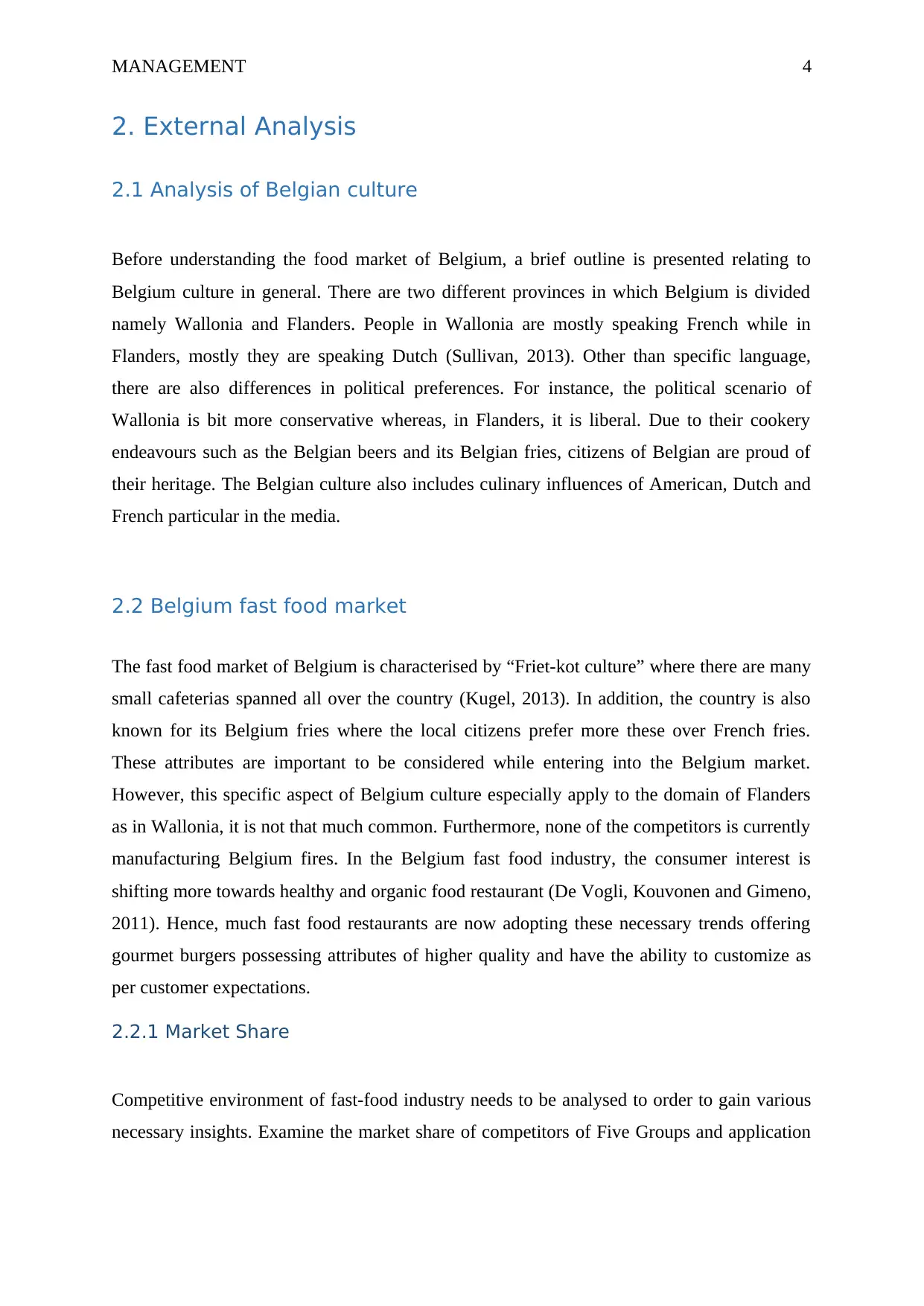
MANAGEMENT 4
2. External Analysis
2.1 Analysis of Belgian culture
Before understanding the food market of Belgium, a brief outline is presented relating to
Belgium culture in general. There are two different provinces in which Belgium is divided
namely Wallonia and Flanders. People in Wallonia are mostly speaking French while in
Flanders, mostly they are speaking Dutch (Sullivan, 2013). Other than specific language,
there are also differences in political preferences. For instance, the political scenario of
Wallonia is bit more conservative whereas, in Flanders, it is liberal. Due to their cookery
endeavours such as the Belgian beers and its Belgian fries, citizens of Belgian are proud of
their heritage. The Belgian culture also includes culinary influences of American, Dutch and
French particular in the media.
2.2 Belgium fast food market
The fast food market of Belgium is characterised by “Friet-kot culture” where there are many
small cafeterias spanned all over the country (Kugel, 2013). In addition, the country is also
known for its Belgium fries where the local citizens prefer more these over French fries.
These attributes are important to be considered while entering into the Belgium market.
However, this specific aspect of Belgium culture especially apply to the domain of Flanders
as in Wallonia, it is not that much common. Furthermore, none of the competitors is currently
manufacturing Belgium fires. In the Belgium fast food industry, the consumer interest is
shifting more towards healthy and organic food restaurant (De Vogli, Kouvonen and Gimeno,
2011). Hence, much fast food restaurants are now adopting these necessary trends offering
gourmet burgers possessing attributes of higher quality and have the ability to customize as
per customer expectations.
2.2.1 Market Share
Competitive environment of fast-food industry needs to be analysed to order to gain various
necessary insights. Examine the market share of competitors of Five Groups and application
2. External Analysis
2.1 Analysis of Belgian culture
Before understanding the food market of Belgium, a brief outline is presented relating to
Belgium culture in general. There are two different provinces in which Belgium is divided
namely Wallonia and Flanders. People in Wallonia are mostly speaking French while in
Flanders, mostly they are speaking Dutch (Sullivan, 2013). Other than specific language,
there are also differences in political preferences. For instance, the political scenario of
Wallonia is bit more conservative whereas, in Flanders, it is liberal. Due to their cookery
endeavours such as the Belgian beers and its Belgian fries, citizens of Belgian are proud of
their heritage. The Belgian culture also includes culinary influences of American, Dutch and
French particular in the media.
2.2 Belgium fast food market
The fast food market of Belgium is characterised by “Friet-kot culture” where there are many
small cafeterias spanned all over the country (Kugel, 2013). In addition, the country is also
known for its Belgium fries where the local citizens prefer more these over French fries.
These attributes are important to be considered while entering into the Belgium market.
However, this specific aspect of Belgium culture especially apply to the domain of Flanders
as in Wallonia, it is not that much common. Furthermore, none of the competitors is currently
manufacturing Belgium fires. In the Belgium fast food industry, the consumer interest is
shifting more towards healthy and organic food restaurant (De Vogli, Kouvonen and Gimeno,
2011). Hence, much fast food restaurants are now adopting these necessary trends offering
gourmet burgers possessing attributes of higher quality and have the ability to customize as
per customer expectations.
2.2.1 Market Share
Competitive environment of fast-food industry needs to be analysed to order to gain various
necessary insights. Examine the market share of competitors of Five Groups and application
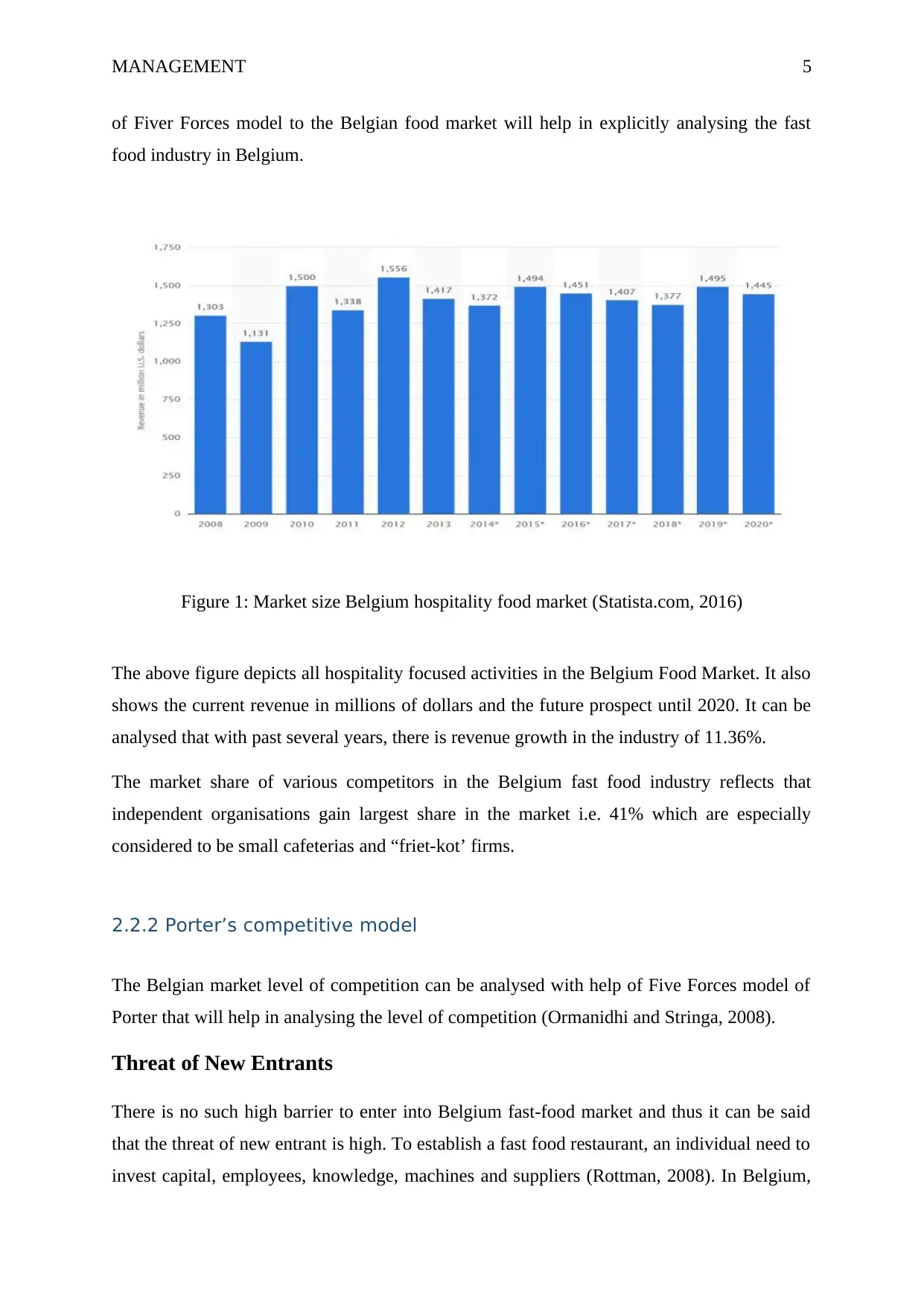
MANAGEMENT 5
of Fiver Forces model to the Belgian food market will help in explicitly analysing the fast
food industry in Belgium.
Figure 1: Market size Belgium hospitality food market (Statista.com, 2016)
The above figure depicts all hospitality focused activities in the Belgium Food Market. It also
shows the current revenue in millions of dollars and the future prospect until 2020. It can be
analysed that with past several years, there is revenue growth in the industry of 11.36%.
The market share of various competitors in the Belgium fast food industry reflects that
independent organisations gain largest share in the market i.e. 41% which are especially
considered to be small cafeterias and “friet-kot’ firms.
2.2.2 Porter’s competitive model
The Belgian market level of competition can be analysed with help of Five Forces model of
Porter that will help in analysing the level of competition (Ormanidhi and Stringa, 2008).
Threat of New Entrants
There is no such high barrier to enter into Belgium fast-food market and thus it can be said
that the threat of new entrant is high. To establish a fast food restaurant, an individual need to
invest capital, employees, knowledge, machines and suppliers (Rottman, 2008). In Belgium,
of Fiver Forces model to the Belgian food market will help in explicitly analysing the fast
food industry in Belgium.
Figure 1: Market size Belgium hospitality food market (Statista.com, 2016)
The above figure depicts all hospitality focused activities in the Belgium Food Market. It also
shows the current revenue in millions of dollars and the future prospect until 2020. It can be
analysed that with past several years, there is revenue growth in the industry of 11.36%.
The market share of various competitors in the Belgium fast food industry reflects that
independent organisations gain largest share in the market i.e. 41% which are especially
considered to be small cafeterias and “friet-kot’ firms.
2.2.2 Porter’s competitive model
The Belgian market level of competition can be analysed with help of Five Forces model of
Porter that will help in analysing the level of competition (Ormanidhi and Stringa, 2008).
Threat of New Entrants
There is no such high barrier to enter into Belgium fast-food market and thus it can be said
that the threat of new entrant is high. To establish a fast food restaurant, an individual need to
invest capital, employees, knowledge, machines and suppliers (Rottman, 2008). In Belgium,
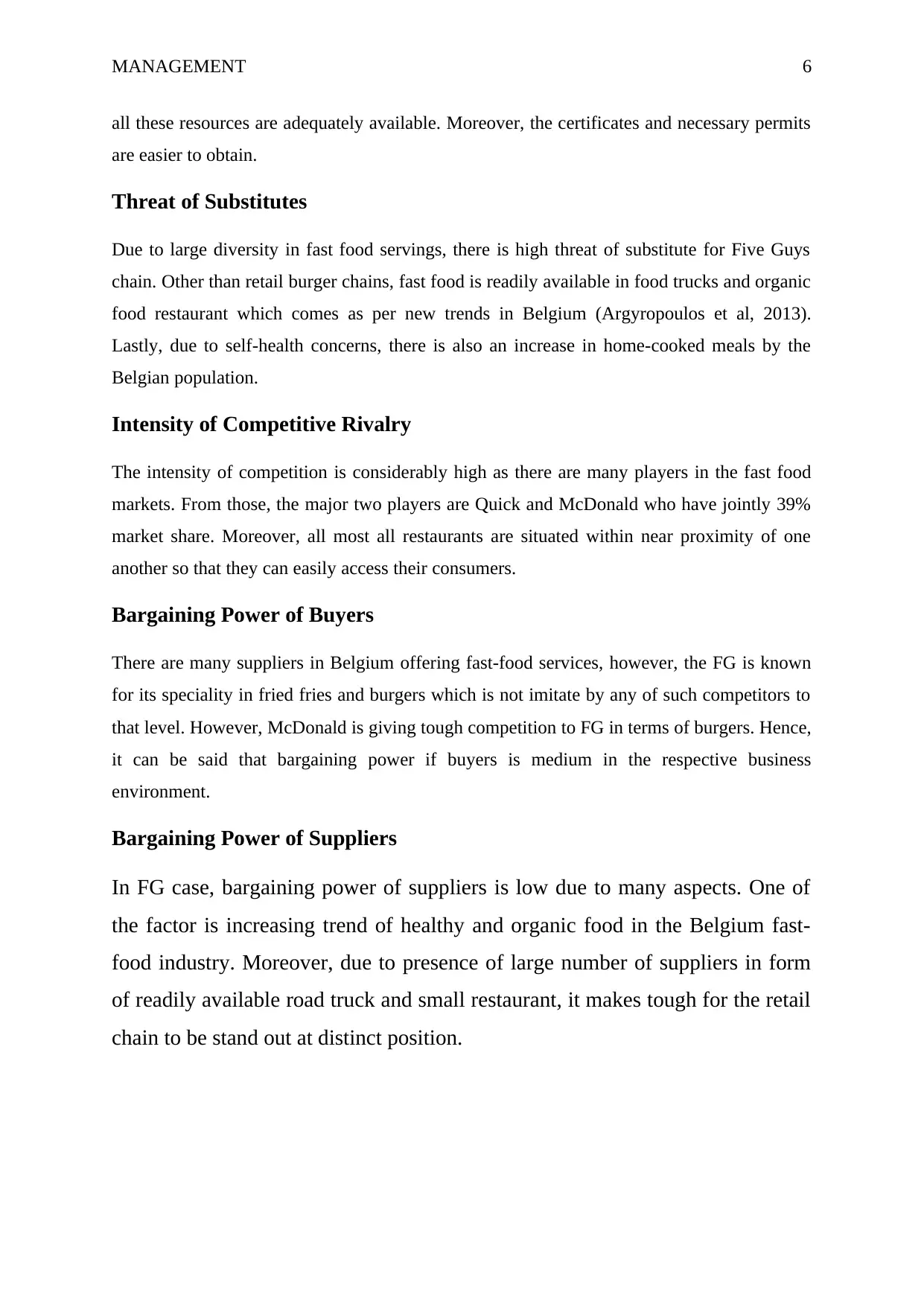
MANAGEMENT 6
all these resources are adequately available. Moreover, the certificates and necessary permits
are easier to obtain.
Threat of Substitutes
Due to large diversity in fast food servings, there is high threat of substitute for Five Guys
chain. Other than retail burger chains, fast food is readily available in food trucks and organic
food restaurant which comes as per new trends in Belgium (Argyropoulos et al, 2013).
Lastly, due to self-health concerns, there is also an increase in home-cooked meals by the
Belgian population.
Intensity of Competitive Rivalry
The intensity of competition is considerably high as there are many players in the fast food
markets. From those, the major two players are Quick and McDonald who have jointly 39%
market share. Moreover, all most all restaurants are situated within near proximity of one
another so that they can easily access their consumers.
Bargaining Power of Buyers
There are many suppliers in Belgium offering fast-food services, however, the FG is known
for its speciality in fried fries and burgers which is not imitate by any of such competitors to
that level. However, McDonald is giving tough competition to FG in terms of burgers. Hence,
it can be said that bargaining power if buyers is medium in the respective business
environment.
Bargaining Power of Suppliers
In FG case, bargaining power of suppliers is low due to many aspects. One of
the factor is increasing trend of healthy and organic food in the Belgium fast-
food industry. Moreover, due to presence of large number of suppliers in form
of readily available road truck and small restaurant, it makes tough for the retail
chain to be stand out at distinct position.
all these resources are adequately available. Moreover, the certificates and necessary permits
are easier to obtain.
Threat of Substitutes
Due to large diversity in fast food servings, there is high threat of substitute for Five Guys
chain. Other than retail burger chains, fast food is readily available in food trucks and organic
food restaurant which comes as per new trends in Belgium (Argyropoulos et al, 2013).
Lastly, due to self-health concerns, there is also an increase in home-cooked meals by the
Belgian population.
Intensity of Competitive Rivalry
The intensity of competition is considerably high as there are many players in the fast food
markets. From those, the major two players are Quick and McDonald who have jointly 39%
market share. Moreover, all most all restaurants are situated within near proximity of one
another so that they can easily access their consumers.
Bargaining Power of Buyers
There are many suppliers in Belgium offering fast-food services, however, the FG is known
for its speciality in fried fries and burgers which is not imitate by any of such competitors to
that level. However, McDonald is giving tough competition to FG in terms of burgers. Hence,
it can be said that bargaining power if buyers is medium in the respective business
environment.
Bargaining Power of Suppliers
In FG case, bargaining power of suppliers is low due to many aspects. One of
the factor is increasing trend of healthy and organic food in the Belgium fast-
food industry. Moreover, due to presence of large number of suppliers in form
of readily available road truck and small restaurant, it makes tough for the retail
chain to be stand out at distinct position.
Paraphrase This Document
Need a fresh take? Get an instant paraphrase of this document with our AI Paraphraser
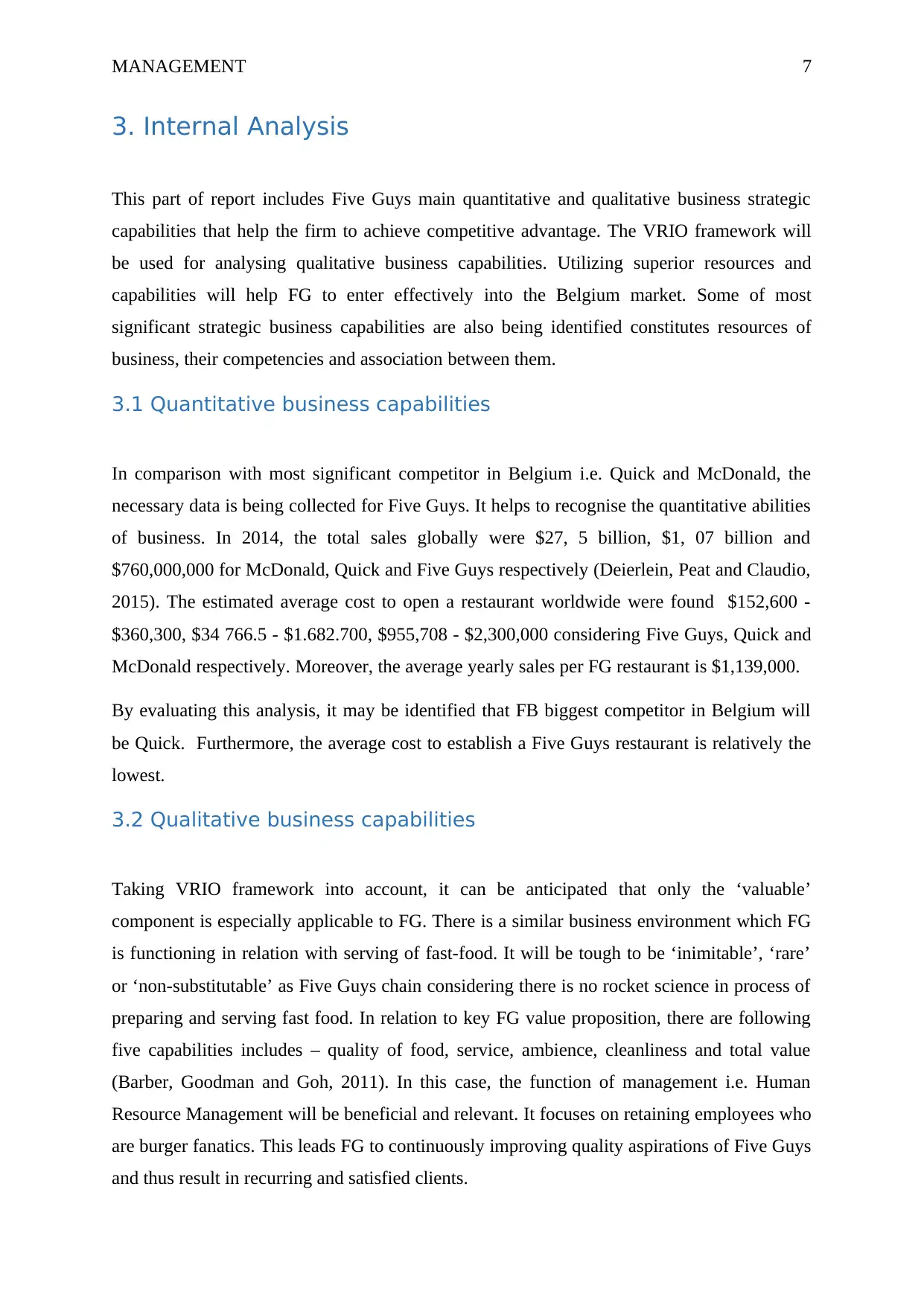
MANAGEMENT 7
3. Internal Analysis
This part of report includes Five Guys main quantitative and qualitative business strategic
capabilities that help the firm to achieve competitive advantage. The VRIO framework will
be used for analysing qualitative business capabilities. Utilizing superior resources and
capabilities will help FG to enter effectively into the Belgium market. Some of most
significant strategic business capabilities are also being identified constitutes resources of
business, their competencies and association between them.
3.1 Quantitative business capabilities
In comparison with most significant competitor in Belgium i.e. Quick and McDonald, the
necessary data is being collected for Five Guys. It helps to recognise the quantitative abilities
of business. In 2014, the total sales globally were $27, 5 billion, $1, 07 billion and
$760,000,000 for McDonald, Quick and Five Guys respectively (Deierlein, Peat and Claudio,
2015). The estimated average cost to open a restaurant worldwide were found $152,600 -
$360,300, $34 766.5 - $1.682.700, $955,708 - $2,300,000 considering Five Guys, Quick and
McDonald respectively. Moreover, the average yearly sales per FG restaurant is $1,139,000.
By evaluating this analysis, it may be identified that FB biggest competitor in Belgium will
be Quick. Furthermore, the average cost to establish a Five Guys restaurant is relatively the
lowest.
3.2 Qualitative business capabilities
Taking VRIO framework into account, it can be anticipated that only the ‘valuable’
component is especially applicable to FG. There is a similar business environment which FG
is functioning in relation with serving of fast-food. It will be tough to be ‘inimitable’, ‘rare’
or ‘non-substitutable’ as Five Guys chain considering there is no rocket science in process of
preparing and serving fast food. In relation to key FG value proposition, there are following
five capabilities includes – quality of food, service, ambience, cleanliness and total value
(Barber, Goodman and Goh, 2011). In this case, the function of management i.e. Human
Resource Management will be beneficial and relevant. It focuses on retaining employees who
are burger fanatics. This leads FG to continuously improving quality aspirations of Five Guys
and thus result in recurring and satisfied clients.
3. Internal Analysis
This part of report includes Five Guys main quantitative and qualitative business strategic
capabilities that help the firm to achieve competitive advantage. The VRIO framework will
be used for analysing qualitative business capabilities. Utilizing superior resources and
capabilities will help FG to enter effectively into the Belgium market. Some of most
significant strategic business capabilities are also being identified constitutes resources of
business, their competencies and association between them.
3.1 Quantitative business capabilities
In comparison with most significant competitor in Belgium i.e. Quick and McDonald, the
necessary data is being collected for Five Guys. It helps to recognise the quantitative abilities
of business. In 2014, the total sales globally were $27, 5 billion, $1, 07 billion and
$760,000,000 for McDonald, Quick and Five Guys respectively (Deierlein, Peat and Claudio,
2015). The estimated average cost to open a restaurant worldwide were found $152,600 -
$360,300, $34 766.5 - $1.682.700, $955,708 - $2,300,000 considering Five Guys, Quick and
McDonald respectively. Moreover, the average yearly sales per FG restaurant is $1,139,000.
By evaluating this analysis, it may be identified that FB biggest competitor in Belgium will
be Quick. Furthermore, the average cost to establish a Five Guys restaurant is relatively the
lowest.
3.2 Qualitative business capabilities
Taking VRIO framework into account, it can be anticipated that only the ‘valuable’
component is especially applicable to FG. There is a similar business environment which FG
is functioning in relation with serving of fast-food. It will be tough to be ‘inimitable’, ‘rare’
or ‘non-substitutable’ as Five Guys chain considering there is no rocket science in process of
preparing and serving fast food. In relation to key FG value proposition, there are following
five capabilities includes – quality of food, service, ambience, cleanliness and total value
(Barber, Goodman and Goh, 2011). In this case, the function of management i.e. Human
Resource Management will be beneficial and relevant. It focuses on retaining employees who
are burger fanatics. This leads FG to continuously improving quality aspirations of Five Guys
and thus result in recurring and satisfied clients.
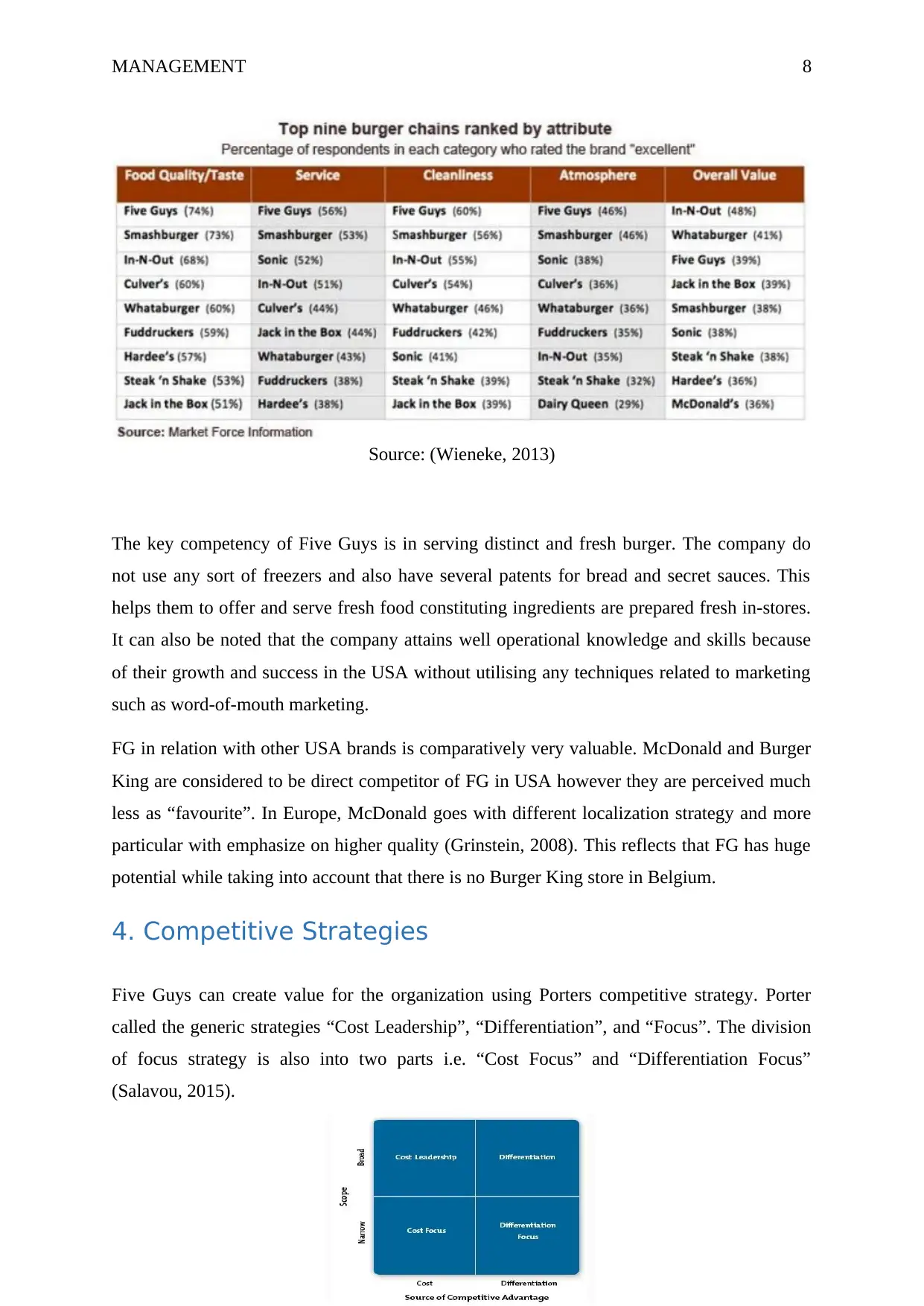
MANAGEMENT 8
Source: (Wieneke, 2013)
The key competency of Five Guys is in serving distinct and fresh burger. The company do
not use any sort of freezers and also have several patents for bread and secret sauces. This
helps them to offer and serve fresh food constituting ingredients are prepared fresh in-stores.
It can also be noted that the company attains well operational knowledge and skills because
of their growth and success in the USA without utilising any techniques related to marketing
such as word-of-mouth marketing.
FG in relation with other USA brands is comparatively very valuable. McDonald and Burger
King are considered to be direct competitor of FG in USA however they are perceived much
less as “favourite”. In Europe, McDonald goes with different localization strategy and more
particular with emphasize on higher quality (Grinstein, 2008). This reflects that FG has huge
potential while taking into account that there is no Burger King store in Belgium.
4. Competitive Strategies
Five Guys can create value for the organization using Porters competitive strategy. Porter
called the generic strategies “Cost Leadership”, “Differentiation”, and “Focus”. The division
of focus strategy is also into two parts i.e. “Cost Focus” and “Differentiation Focus”
(Salavou, 2015).
Source: (Wieneke, 2013)
The key competency of Five Guys is in serving distinct and fresh burger. The company do
not use any sort of freezers and also have several patents for bread and secret sauces. This
helps them to offer and serve fresh food constituting ingredients are prepared fresh in-stores.
It can also be noted that the company attains well operational knowledge and skills because
of their growth and success in the USA without utilising any techniques related to marketing
such as word-of-mouth marketing.
FG in relation with other USA brands is comparatively very valuable. McDonald and Burger
King are considered to be direct competitor of FG in USA however they are perceived much
less as “favourite”. In Europe, McDonald goes with different localization strategy and more
particular with emphasize on higher quality (Grinstein, 2008). This reflects that FG has huge
potential while taking into account that there is no Burger King store in Belgium.
4. Competitive Strategies
Five Guys can create value for the organization using Porters competitive strategy. Porter
called the generic strategies “Cost Leadership”, “Differentiation”, and “Focus”. The division
of focus strategy is also into two parts i.e. “Cost Focus” and “Differentiation Focus”
(Salavou, 2015).
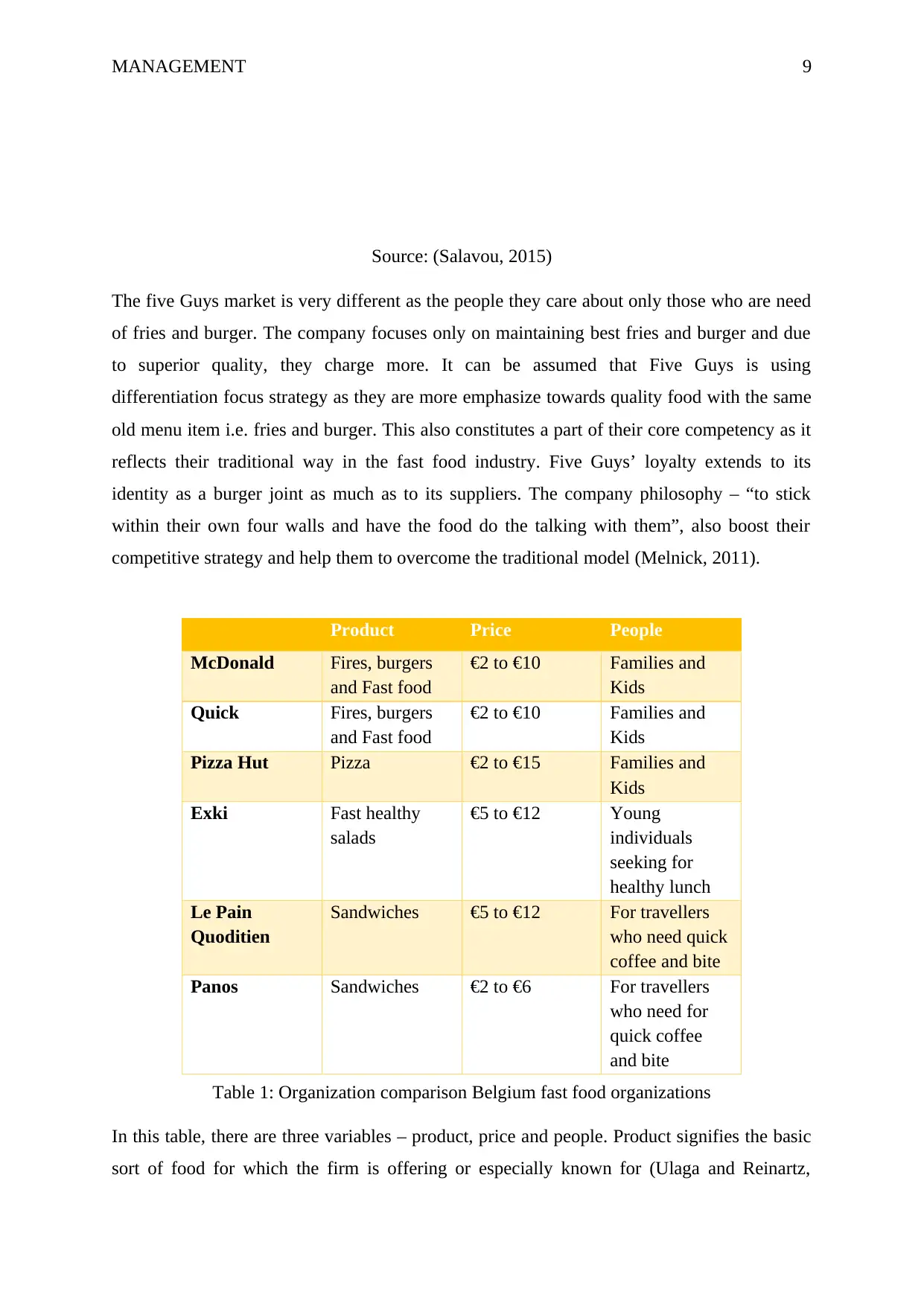
MANAGEMENT 9
Source: (Salavou, 2015)
The five Guys market is very different as the people they care about only those who are need
of fries and burger. The company focuses only on maintaining best fries and burger and due
to superior quality, they charge more. It can be assumed that Five Guys is using
differentiation focus strategy as they are more emphasize towards quality food with the same
old menu item i.e. fries and burger. This also constitutes a part of their core competency as it
reflects their traditional way in the fast food industry. Five Guys’ loyalty extends to its
identity as a burger joint as much as to its suppliers. The company philosophy – “to stick
within their own four walls and have the food do the talking with them”, also boost their
competitive strategy and help them to overcome the traditional model (Melnick, 2011).
Table 1: Organization comparison Belgium fast food organizations
In this table, there are three variables – product, price and people. Product signifies the basic
sort of food for which the firm is offering or especially known for (Ulaga and Reinartz,
Product Price People
McDonald Fires, burgers
and Fast food
€2 to €10 Families and
Kids
Quick Fires, burgers
and Fast food
€2 to €10 Families and
Kids
Pizza Hut Pizza €2 to €15 Families and
Kids
Exki Fast healthy
salads
€5 to €12 Young
individuals
seeking for
healthy lunch
Le Pain
Quoditien
Sandwiches €5 to €12 For travellers
who need quick
coffee and bite
Panos Sandwiches €2 to €6 For travellers
who need for
quick coffee
and bite
Source: (Salavou, 2015)
The five Guys market is very different as the people they care about only those who are need
of fries and burger. The company focuses only on maintaining best fries and burger and due
to superior quality, they charge more. It can be assumed that Five Guys is using
differentiation focus strategy as they are more emphasize towards quality food with the same
old menu item i.e. fries and burger. This also constitutes a part of their core competency as it
reflects their traditional way in the fast food industry. Five Guys’ loyalty extends to its
identity as a burger joint as much as to its suppliers. The company philosophy – “to stick
within their own four walls and have the food do the talking with them”, also boost their
competitive strategy and help them to overcome the traditional model (Melnick, 2011).
Table 1: Organization comparison Belgium fast food organizations
In this table, there are three variables – product, price and people. Product signifies the basic
sort of food for which the firm is offering or especially known for (Ulaga and Reinartz,
Product Price People
McDonald Fires, burgers
and Fast food
€2 to €10 Families and
Kids
Quick Fires, burgers
and Fast food
€2 to €10 Families and
Kids
Pizza Hut Pizza €2 to €15 Families and
Kids
Exki Fast healthy
salads
€5 to €12 Young
individuals
seeking for
healthy lunch
Le Pain
Quoditien
Sandwiches €5 to €12 For travellers
who need quick
coffee and bite
Panos Sandwiches €2 to €6 For travellers
who need for
quick coffee
and bite
Secure Best Marks with AI Grader
Need help grading? Try our AI Grader for instant feedback on your assignments.
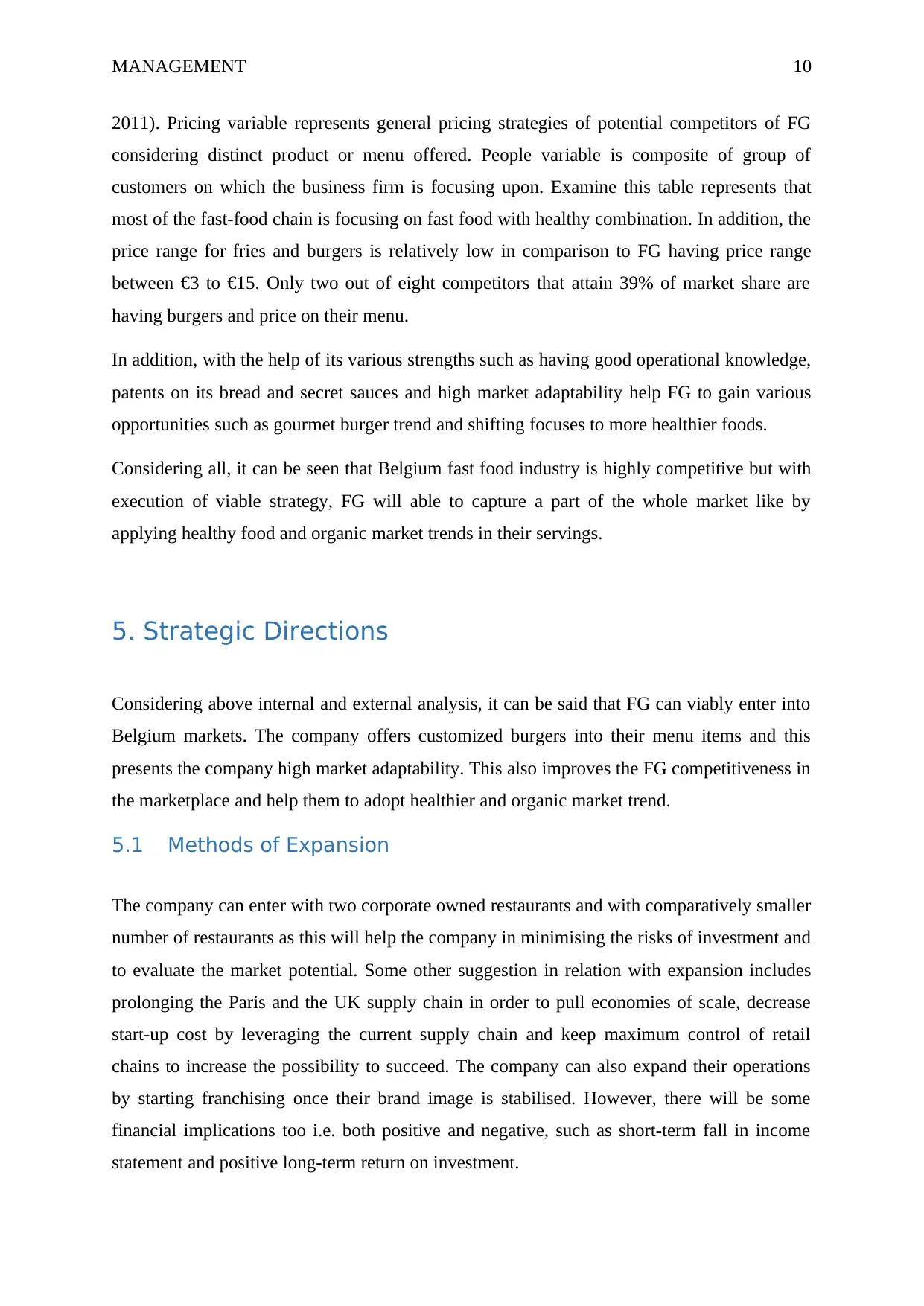
MANAGEMENT 10
2011). Pricing variable represents general pricing strategies of potential competitors of FG
considering distinct product or menu offered. People variable is composite of group of
customers on which the business firm is focusing upon. Examine this table represents that
most of the fast-food chain is focusing on fast food with healthy combination. In addition, the
price range for fries and burgers is relatively low in comparison to FG having price range
between €3 to €15. Only two out of eight competitors that attain 39% of market share are
having burgers and price on their menu.
In addition, with the help of its various strengths such as having good operational knowledge,
patents on its bread and secret sauces and high market adaptability help FG to gain various
opportunities such as gourmet burger trend and shifting focuses to more healthier foods.
Considering all, it can be seen that Belgium fast food industry is highly competitive but with
execution of viable strategy, FG will able to capture a part of the whole market like by
applying healthy food and organic market trends in their servings.
5. Strategic Directions
Considering above internal and external analysis, it can be said that FG can viably enter into
Belgium markets. The company offers customized burgers into their menu items and this
presents the company high market adaptability. This also improves the FG competitiveness in
the marketplace and help them to adopt healthier and organic market trend.
5.1 Methods of Expansion
The company can enter with two corporate owned restaurants and with comparatively smaller
number of restaurants as this will help the company in minimising the risks of investment and
to evaluate the market potential. Some other suggestion in relation with expansion includes
prolonging the Paris and the UK supply chain in order to pull economies of scale, decrease
start-up cost by leveraging the current supply chain and keep maximum control of retail
chains to increase the possibility to succeed. The company can also expand their operations
by starting franchising once their brand image is stabilised. However, there will be some
financial implications too i.e. both positive and negative, such as short-term fall in income
statement and positive long-term return on investment.
2011). Pricing variable represents general pricing strategies of potential competitors of FG
considering distinct product or menu offered. People variable is composite of group of
customers on which the business firm is focusing upon. Examine this table represents that
most of the fast-food chain is focusing on fast food with healthy combination. In addition, the
price range for fries and burgers is relatively low in comparison to FG having price range
between €3 to €15. Only two out of eight competitors that attain 39% of market share are
having burgers and price on their menu.
In addition, with the help of its various strengths such as having good operational knowledge,
patents on its bread and secret sauces and high market adaptability help FG to gain various
opportunities such as gourmet burger trend and shifting focuses to more healthier foods.
Considering all, it can be seen that Belgium fast food industry is highly competitive but with
execution of viable strategy, FG will able to capture a part of the whole market like by
applying healthy food and organic market trends in their servings.
5. Strategic Directions
Considering above internal and external analysis, it can be said that FG can viably enter into
Belgium markets. The company offers customized burgers into their menu items and this
presents the company high market adaptability. This also improves the FG competitiveness in
the marketplace and help them to adopt healthier and organic market trend.
5.1 Methods of Expansion
The company can enter with two corporate owned restaurants and with comparatively smaller
number of restaurants as this will help the company in minimising the risks of investment and
to evaluate the market potential. Some other suggestion in relation with expansion includes
prolonging the Paris and the UK supply chain in order to pull economies of scale, decrease
start-up cost by leveraging the current supply chain and keep maximum control of retail
chains to increase the possibility to succeed. The company can also expand their operations
by starting franchising once their brand image is stabilised. However, there will be some
financial implications too i.e. both positive and negative, such as short-term fall in income
statement and positive long-term return on investment.
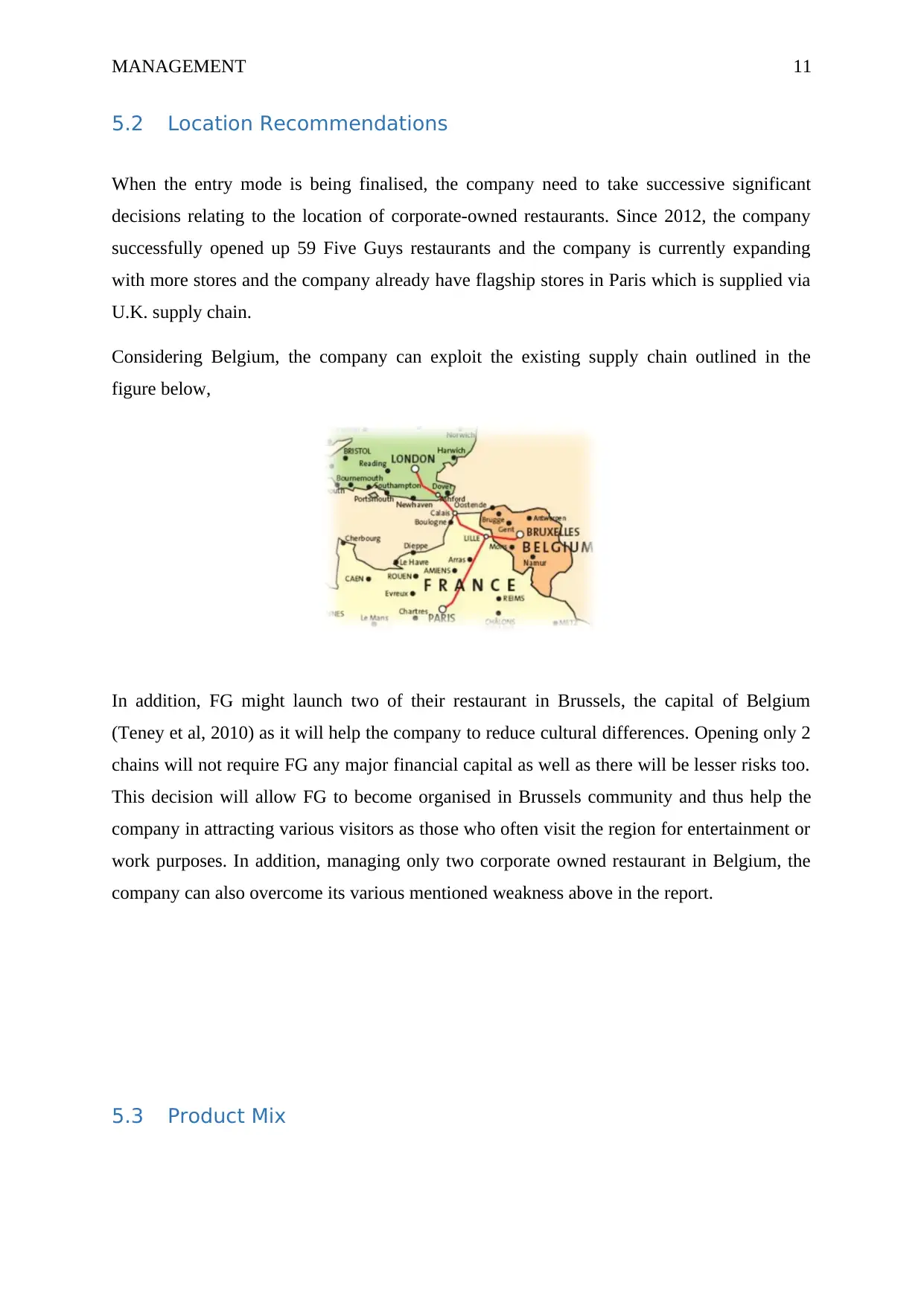
MANAGEMENT 11
5.2 Location Recommendations
When the entry mode is being finalised, the company need to take successive significant
decisions relating to the location of corporate-owned restaurants. Since 2012, the company
successfully opened up 59 Five Guys restaurants and the company is currently expanding
with more stores and the company already have flagship stores in Paris which is supplied via
U.K. supply chain.
Considering Belgium, the company can exploit the existing supply chain outlined in the
figure below,
In addition, FG might launch two of their restaurant in Brussels, the capital of Belgium
(Teney et al, 2010) as it will help the company to reduce cultural differences. Opening only 2
chains will not require FG any major financial capital as well as there will be lesser risks too.
This decision will allow FG to become organised in Brussels community and thus help the
company in attracting various visitors as those who often visit the region for entertainment or
work purposes. In addition, managing only two corporate owned restaurant in Belgium, the
company can also overcome its various mentioned weakness above in the report.
5.3 Product Mix
5.2 Location Recommendations
When the entry mode is being finalised, the company need to take successive significant
decisions relating to the location of corporate-owned restaurants. Since 2012, the company
successfully opened up 59 Five Guys restaurants and the company is currently expanding
with more stores and the company already have flagship stores in Paris which is supplied via
U.K. supply chain.
Considering Belgium, the company can exploit the existing supply chain outlined in the
figure below,
In addition, FG might launch two of their restaurant in Brussels, the capital of Belgium
(Teney et al, 2010) as it will help the company to reduce cultural differences. Opening only 2
chains will not require FG any major financial capital as well as there will be lesser risks too.
This decision will allow FG to become organised in Brussels community and thus help the
company in attracting various visitors as those who often visit the region for entertainment or
work purposes. In addition, managing only two corporate owned restaurant in Belgium, the
company can also overcome its various mentioned weakness above in the report.
5.3 Product Mix
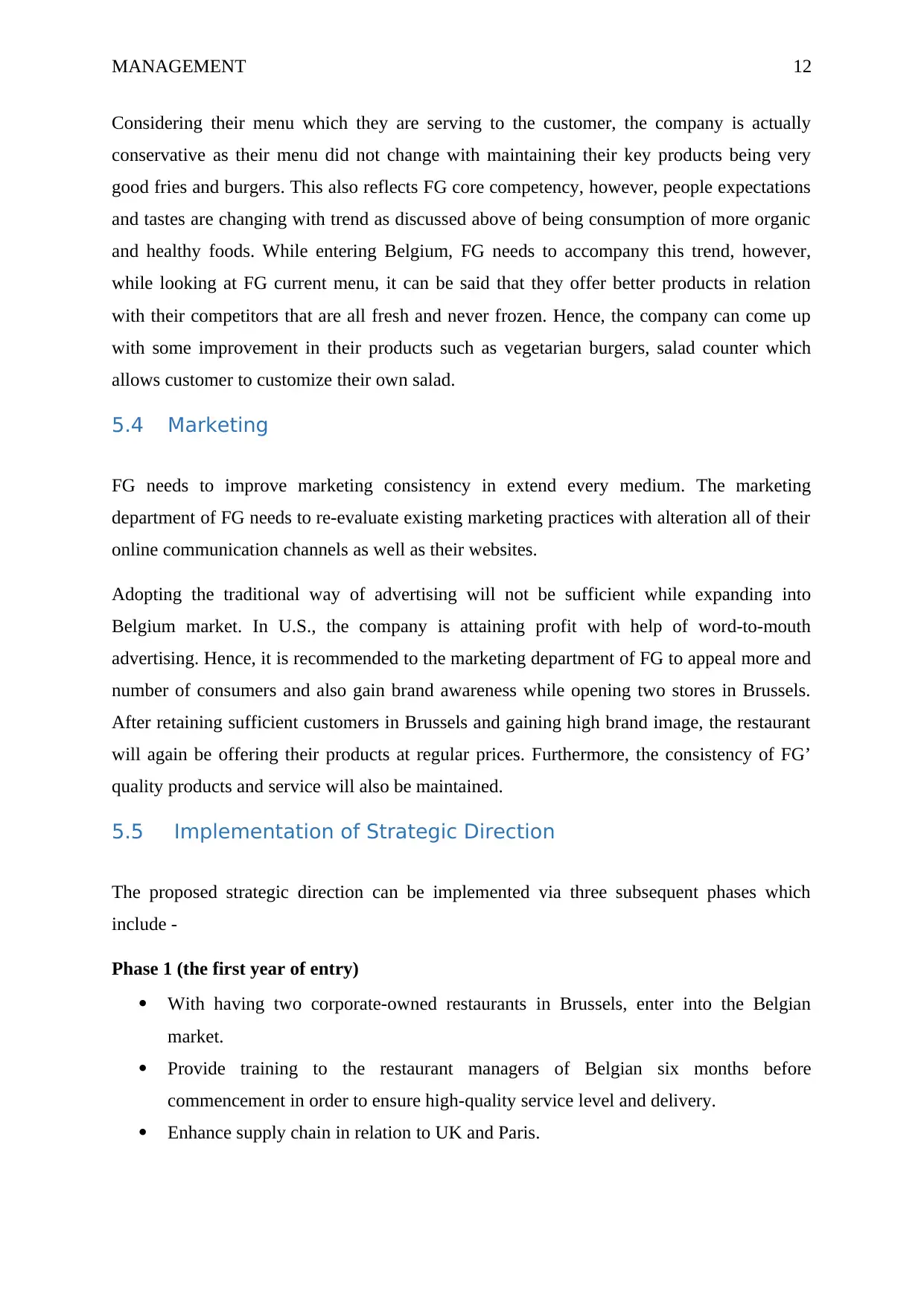
MANAGEMENT 12
Considering their menu which they are serving to the customer, the company is actually
conservative as their menu did not change with maintaining their key products being very
good fries and burgers. This also reflects FG core competency, however, people expectations
and tastes are changing with trend as discussed above of being consumption of more organic
and healthy foods. While entering Belgium, FG needs to accompany this trend, however,
while looking at FG current menu, it can be said that they offer better products in relation
with their competitors that are all fresh and never frozen. Hence, the company can come up
with some improvement in their products such as vegetarian burgers, salad counter which
allows customer to customize their own salad.
5.4 Marketing
FG needs to improve marketing consistency in extend every medium. The marketing
department of FG needs to re-evaluate existing marketing practices with alteration all of their
online communication channels as well as their websites.
Adopting the traditional way of advertising will not be sufficient while expanding into
Belgium market. In U.S., the company is attaining profit with help of word-to-mouth
advertising. Hence, it is recommended to the marketing department of FG to appeal more and
number of consumers and also gain brand awareness while opening two stores in Brussels.
After retaining sufficient customers in Brussels and gaining high brand image, the restaurant
will again be offering their products at regular prices. Furthermore, the consistency of FG’
quality products and service will also be maintained.
5.5 Implementation of Strategic Direction
The proposed strategic direction can be implemented via three subsequent phases which
include -
Phase 1 (the first year of entry)
With having two corporate-owned restaurants in Brussels, enter into the Belgian
market.
Provide training to the restaurant managers of Belgian six months before
commencement in order to ensure high-quality service level and delivery.
Enhance supply chain in relation to UK and Paris.
Considering their menu which they are serving to the customer, the company is actually
conservative as their menu did not change with maintaining their key products being very
good fries and burgers. This also reflects FG core competency, however, people expectations
and tastes are changing with trend as discussed above of being consumption of more organic
and healthy foods. While entering Belgium, FG needs to accompany this trend, however,
while looking at FG current menu, it can be said that they offer better products in relation
with their competitors that are all fresh and never frozen. Hence, the company can come up
with some improvement in their products such as vegetarian burgers, salad counter which
allows customer to customize their own salad.
5.4 Marketing
FG needs to improve marketing consistency in extend every medium. The marketing
department of FG needs to re-evaluate existing marketing practices with alteration all of their
online communication channels as well as their websites.
Adopting the traditional way of advertising will not be sufficient while expanding into
Belgium market. In U.S., the company is attaining profit with help of word-to-mouth
advertising. Hence, it is recommended to the marketing department of FG to appeal more and
number of consumers and also gain brand awareness while opening two stores in Brussels.
After retaining sufficient customers in Brussels and gaining high brand image, the restaurant
will again be offering their products at regular prices. Furthermore, the consistency of FG’
quality products and service will also be maintained.
5.5 Implementation of Strategic Direction
The proposed strategic direction can be implemented via three subsequent phases which
include -
Phase 1 (the first year of entry)
With having two corporate-owned restaurants in Brussels, enter into the Belgian
market.
Provide training to the restaurant managers of Belgian six months before
commencement in order to ensure high-quality service level and delivery.
Enhance supply chain in relation to UK and Paris.
Paraphrase This Document
Need a fresh take? Get an instant paraphrase of this document with our AI Paraphraser
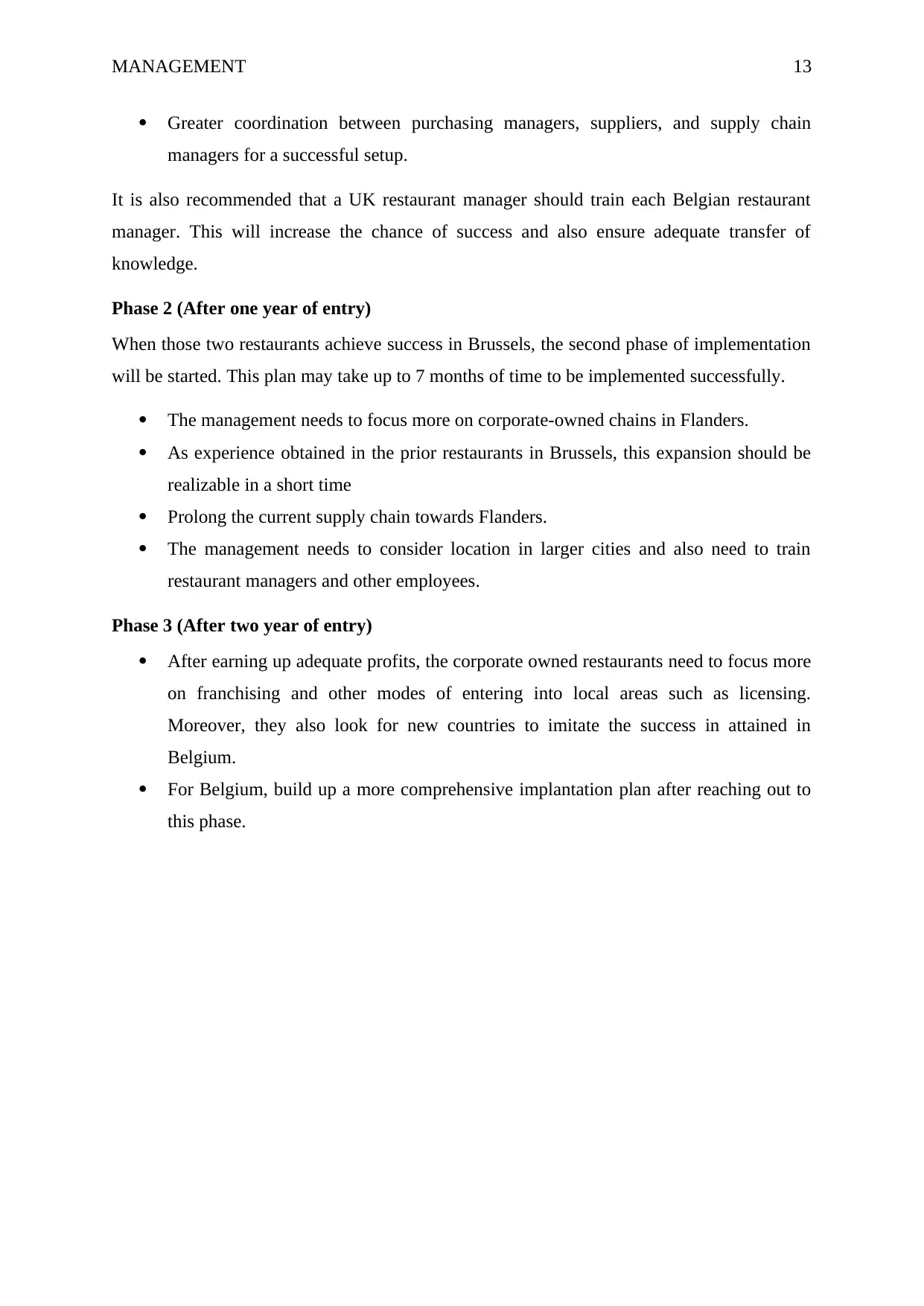
MANAGEMENT 13
Greater coordination between purchasing managers, suppliers, and supply chain
managers for a successful setup.
It is also recommended that a UK restaurant manager should train each Belgian restaurant
manager. This will increase the chance of success and also ensure adequate transfer of
knowledge.
Phase 2 (After one year of entry)
When those two restaurants achieve success in Brussels, the second phase of implementation
will be started. This plan may take up to 7 months of time to be implemented successfully.
The management needs to focus more on corporate-owned chains in Flanders.
As experience obtained in the prior restaurants in Brussels, this expansion should be
realizable in a short time
Prolong the current supply chain towards Flanders.
The management needs to consider location in larger cities and also need to train
restaurant managers and other employees.
Phase 3 (After two year of entry)
After earning up adequate profits, the corporate owned restaurants need to focus more
on franchising and other modes of entering into local areas such as licensing.
Moreover, they also look for new countries to imitate the success in attained in
Belgium.
For Belgium, build up a more comprehensive implantation plan after reaching out to
this phase.
Greater coordination between purchasing managers, suppliers, and supply chain
managers for a successful setup.
It is also recommended that a UK restaurant manager should train each Belgian restaurant
manager. This will increase the chance of success and also ensure adequate transfer of
knowledge.
Phase 2 (After one year of entry)
When those two restaurants achieve success in Brussels, the second phase of implementation
will be started. This plan may take up to 7 months of time to be implemented successfully.
The management needs to focus more on corporate-owned chains in Flanders.
As experience obtained in the prior restaurants in Brussels, this expansion should be
realizable in a short time
Prolong the current supply chain towards Flanders.
The management needs to consider location in larger cities and also need to train
restaurant managers and other employees.
Phase 3 (After two year of entry)
After earning up adequate profits, the corporate owned restaurants need to focus more
on franchising and other modes of entering into local areas such as licensing.
Moreover, they also look for new countries to imitate the success in attained in
Belgium.
For Belgium, build up a more comprehensive implantation plan after reaching out to
this phase.
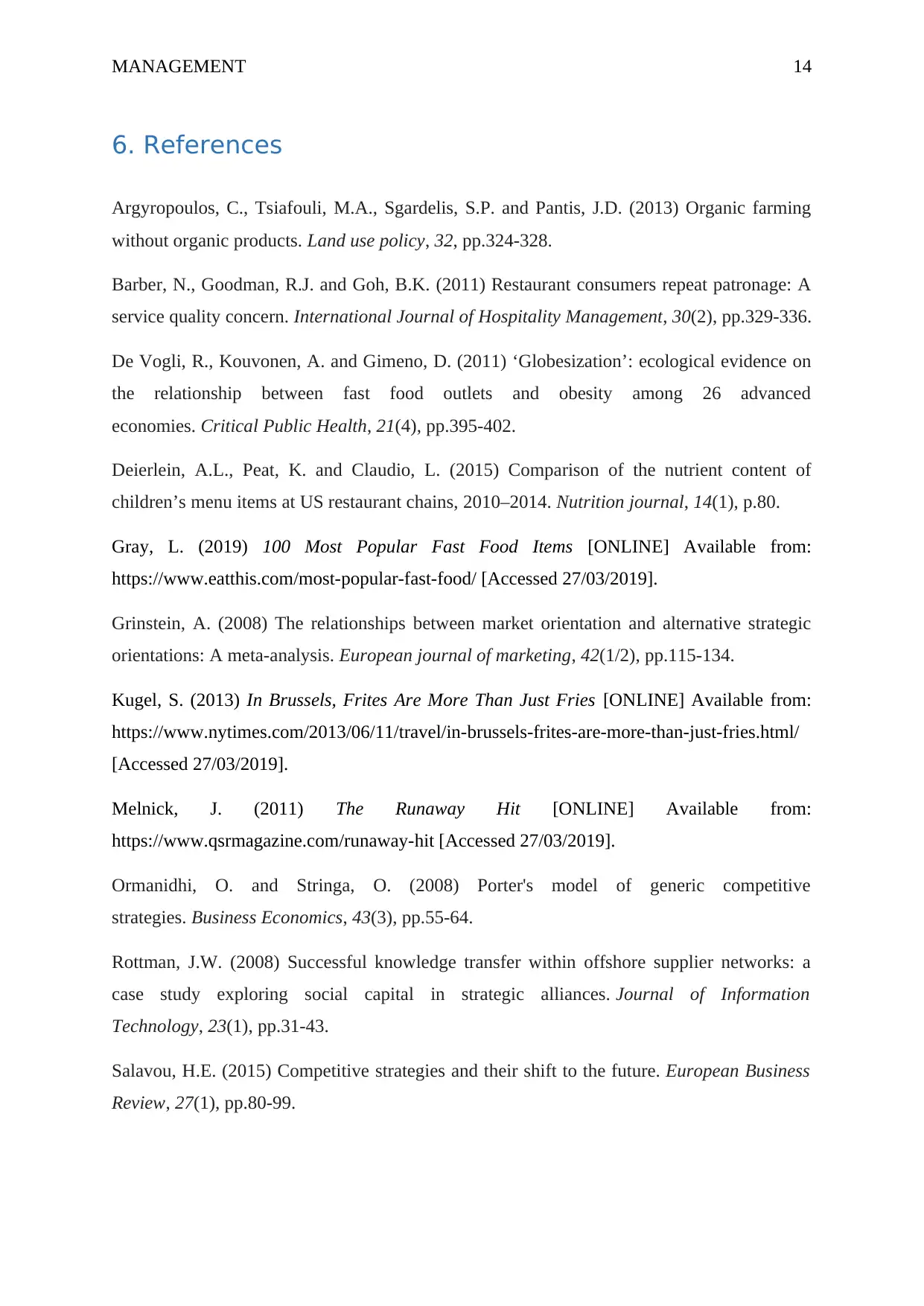
MANAGEMENT 14
6. References
Argyropoulos, C., Tsiafouli, M.A., Sgardelis, S.P. and Pantis, J.D. (2013) Organic farming
without organic products. Land use policy, 32, pp.324-328.
Barber, N., Goodman, R.J. and Goh, B.K. (2011) Restaurant consumers repeat patronage: A
service quality concern. International Journal of Hospitality Management, 30(2), pp.329-336.
De Vogli, R., Kouvonen, A. and Gimeno, D. (2011) ‘Globesization’: ecological evidence on
the relationship between fast food outlets and obesity among 26 advanced
economies. Critical Public Health, 21(4), pp.395-402.
Deierlein, A.L., Peat, K. and Claudio, L. (2015) Comparison of the nutrient content of
children’s menu items at US restaurant chains, 2010–2014. Nutrition journal, 14(1), p.80.
Gray, L. (2019) 100 Most Popular Fast Food Items [ONLINE] Available from:
https://www.eatthis.com/most-popular-fast-food/ [Accessed 27/03/2019].
Grinstein, A. (2008) The relationships between market orientation and alternative strategic
orientations: A meta-analysis. European journal of marketing, 42(1/2), pp.115-134.
Kugel, S. (2013) In Brussels, Frites Are More Than Just Fries [ONLINE] Available from:
https://www.nytimes.com/2013/06/11/travel/in-brussels-frites-are-more-than-just-fries.html/
[Accessed 27/03/2019].
Melnick, J. (2011) The Runaway Hit [ONLINE] Available from:
https://www.qsrmagazine.com/runaway-hit [Accessed 27/03/2019].
Ormanidhi, O. and Stringa, O. (2008) Porter's model of generic competitive
strategies. Business Economics, 43(3), pp.55-64.
Rottman, J.W. (2008) Successful knowledge transfer within offshore supplier networks: a
case study exploring social capital in strategic alliances. Journal of Information
Technology, 23(1), pp.31-43.
Salavou, H.E. (2015) Competitive strategies and their shift to the future. European Business
Review, 27(1), pp.80-99.
6. References
Argyropoulos, C., Tsiafouli, M.A., Sgardelis, S.P. and Pantis, J.D. (2013) Organic farming
without organic products. Land use policy, 32, pp.324-328.
Barber, N., Goodman, R.J. and Goh, B.K. (2011) Restaurant consumers repeat patronage: A
service quality concern. International Journal of Hospitality Management, 30(2), pp.329-336.
De Vogli, R., Kouvonen, A. and Gimeno, D. (2011) ‘Globesization’: ecological evidence on
the relationship between fast food outlets and obesity among 26 advanced
economies. Critical Public Health, 21(4), pp.395-402.
Deierlein, A.L., Peat, K. and Claudio, L. (2015) Comparison of the nutrient content of
children’s menu items at US restaurant chains, 2010–2014. Nutrition journal, 14(1), p.80.
Gray, L. (2019) 100 Most Popular Fast Food Items [ONLINE] Available from:
https://www.eatthis.com/most-popular-fast-food/ [Accessed 27/03/2019].
Grinstein, A. (2008) The relationships between market orientation and alternative strategic
orientations: A meta-analysis. European journal of marketing, 42(1/2), pp.115-134.
Kugel, S. (2013) In Brussels, Frites Are More Than Just Fries [ONLINE] Available from:
https://www.nytimes.com/2013/06/11/travel/in-brussels-frites-are-more-than-just-fries.html/
[Accessed 27/03/2019].
Melnick, J. (2011) The Runaway Hit [ONLINE] Available from:
https://www.qsrmagazine.com/runaway-hit [Accessed 27/03/2019].
Ormanidhi, O. and Stringa, O. (2008) Porter's model of generic competitive
strategies. Business Economics, 43(3), pp.55-64.
Rottman, J.W. (2008) Successful knowledge transfer within offshore supplier networks: a
case study exploring social capital in strategic alliances. Journal of Information
Technology, 23(1), pp.31-43.
Salavou, H.E. (2015) Competitive strategies and their shift to the future. European Business
Review, 27(1), pp.80-99.
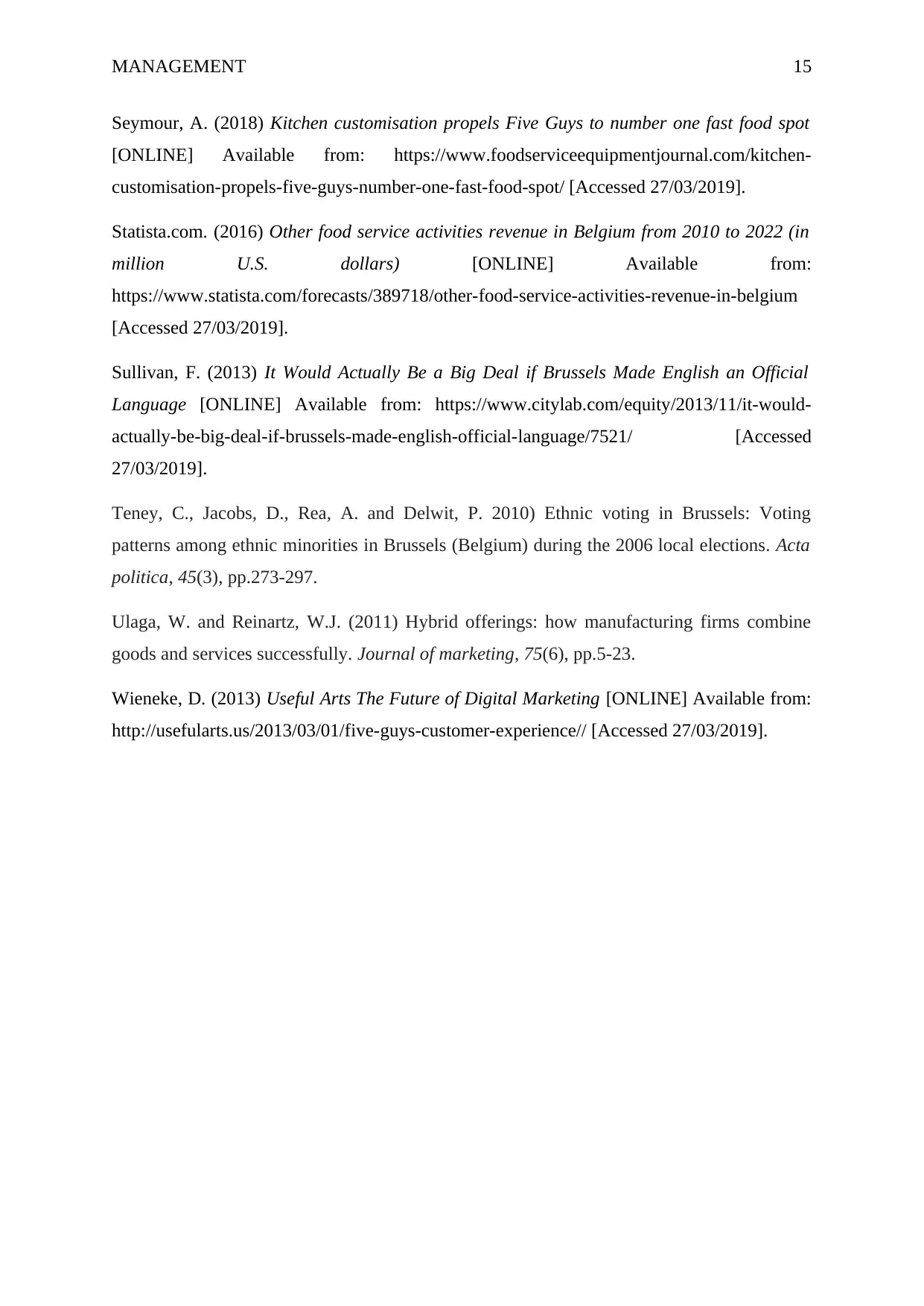
MANAGEMENT 15
Seymour, A. (2018) Kitchen customisation propels Five Guys to number one fast food spot
[ONLINE] Available from: https://www.foodserviceequipmentjournal.com/kitchen-
customisation-propels-five-guys-number-one-fast-food-spot/ [Accessed 27/03/2019].
Statista.com. (2016) Other food service activities revenue in Belgium from 2010 to 2022 (in
million U.S. dollars) [ONLINE] Available from:
https://www.statista.com/forecasts/389718/other-food-service-activities-revenue-in-belgium
[Accessed 27/03/2019].
Sullivan, F. (2013) It Would Actually Be a Big Deal if Brussels Made English an Official
Language [ONLINE] Available from: https://www.citylab.com/equity/2013/11/it-would-
actually-be-big-deal-if-brussels-made-english-official-language/7521/ [Accessed
27/03/2019].
Teney, C., Jacobs, D., Rea, A. and Delwit, P. 2010) Ethnic voting in Brussels: Voting
patterns among ethnic minorities in Brussels (Belgium) during the 2006 local elections. Acta
politica, 45(3), pp.273-297.
Ulaga, W. and Reinartz, W.J. (2011) Hybrid offerings: how manufacturing firms combine
goods and services successfully. Journal of marketing, 75(6), pp.5-23.
Wieneke, D. (2013) Useful Arts The Future of Digital Marketing [ONLINE] Available from:
http://usefularts.us/2013/03/01/five-guys-customer-experience// [Accessed 27/03/2019].
Seymour, A. (2018) Kitchen customisation propels Five Guys to number one fast food spot
[ONLINE] Available from: https://www.foodserviceequipmentjournal.com/kitchen-
customisation-propels-five-guys-number-one-fast-food-spot/ [Accessed 27/03/2019].
Statista.com. (2016) Other food service activities revenue in Belgium from 2010 to 2022 (in
million U.S. dollars) [ONLINE] Available from:
https://www.statista.com/forecasts/389718/other-food-service-activities-revenue-in-belgium
[Accessed 27/03/2019].
Sullivan, F. (2013) It Would Actually Be a Big Deal if Brussels Made English an Official
Language [ONLINE] Available from: https://www.citylab.com/equity/2013/11/it-would-
actually-be-big-deal-if-brussels-made-english-official-language/7521/ [Accessed
27/03/2019].
Teney, C., Jacobs, D., Rea, A. and Delwit, P. 2010) Ethnic voting in Brussels: Voting
patterns among ethnic minorities in Brussels (Belgium) during the 2006 local elections. Acta
politica, 45(3), pp.273-297.
Ulaga, W. and Reinartz, W.J. (2011) Hybrid offerings: how manufacturing firms combine
goods and services successfully. Journal of marketing, 75(6), pp.5-23.
Wieneke, D. (2013) Useful Arts The Future of Digital Marketing [ONLINE] Available from:
http://usefularts.us/2013/03/01/five-guys-customer-experience// [Accessed 27/03/2019].
1 out of 16
Related Documents
Your All-in-One AI-Powered Toolkit for Academic Success.
+13062052269
info@desklib.com
Available 24*7 on WhatsApp / Email
![[object Object]](/_next/static/media/star-bottom.7253800d.svg)
Unlock your academic potential
© 2024 | Zucol Services PVT LTD | All rights reserved.





